An Island museum and landmark changed hands on Patriots Day. The museum of the Sea Coast Defense Chapter of the Daughters of the American Revolution, a little white building on upper Main street in Vineyard Haven, has turned over to Martha’s Vineyard Historical Preservation Society. The museum is a repository of memorabilia going back generations, to the Island’s whaling days.
The ceremony was short Monday morning. A Betsy Ross 13-star American flag was raised upon the 67-foot liberty pole next to the steps to the museum. Jean Swift, regent for the DAR, handed a set of keys to Jane Tomassian, executive director for the historical preservation society.
For Miss Swift, it was a relief to know that this piece of the Island’s history is in good hands. The old former schoolhouse, built in the early 1800s, hadn’t been opened regularly to the public in recent years. The roof required serious mending. Membership was off in the DAR and there was little money for maintenance. Miss Swift saw the transfer was a necessary change to save the old museum.
For Mrs. Tomassian it was a new acquisition for the society, another historic institution protected. She promised that the museum will have regular open hours this summer. The public will be admitted for free. And she promised the building will be restored. Mrs. Tomassian said a new sense of historic enthusiasm will come from within those old schoolhouse doors.
For Alison Convery, president of the preservation society, it was an opportunity to wander along the display cases in the museum with her husband, Leo, and to marvel over the collection. “We are all interested in seeing that this museum gets the attention it needs,” Mrs. Convery said. “We can bring in a knowledgeable group of people to help in further catalogueing the items. They have an outstanding scrimshaw collection. There are so many things that were brought here from the South Seas by whaling captains. It is uncommon to find in an old New England community a collection such as this - Indian figureheads, masks from Africa - all brought over by whalemen.”
For William Honey, former president of the Martha’s VIneyard National Bank and trustee member of the preservation society, the ceremony marked an end to his concerns about the museum’s future. Last summer Mr, Honey initiated the first steps to bring the DAR museum into the protective custody of the preservation society. “I have been worried about the building for a number of years,” he said. “Then it was mentioned that the society was looking to broaden its activities into other towns - to step out and preserve other important sites on the Island.” The preservation society, founded in 1973, currently owns the Old Whaling Church in Edgartown, the Ritter House (home of the Tisbury Museum) in Vineyard Haven, and the Vincent House and the Daniel Fisher House, both in Edgartown.
Acquiring the DAR museum “was one of those things that happened to work out easily,” Mr. Honey said.
Mrs. Tomassian and Miss Swift held luncheon meetings to discuss the transfer in the fall. An offer was made to the DAR and Mrs. Swift wrote a letter of appeal to the 15 remaining members for acceptance in November.
Miss Swift wrote: “Your regent believes that the time has come to accept this offer. Our chapter is diminishing and we have neither the finances to make repairs nor the membership capable of making such arrangements. Our building deserves to be able to hold up its head in dignity as an important landmark in Tisbury history. Please accept this offer to help.”
Miss Swift said this week: “Nine people including myself decided to go with the offer. It was too bad, but it is the only thing we can do.”
On the wall a portrait of Nathan Mayhew, the building’s first schoolmaster, peers down on the classroom. This schoolmaster, for whom The Nathan Mayhew Seminars is named, set standards of education on the Island that were recognized for generations. Mr. Mayhew began the school as a private school in the early 1800s. Later the schoolhouse became part of the town public school.
After the Civil War, the facility was used by a number of churches.
Mrs. Tomassian said the building was used as a chapel by Congregationalists, Unitarians and Baptists. It even had a bellfry and a bell at one time. It was used just before the turn of the century as an undertaker’s parlor.
On July 17, 1903, the dedication of the building as a historic hall was reported by the Vineyard Gazette:
“Yesterday was indeed a red letter day in the career of Seacoast Defence chapter, Daughters of the American Revolution, as well as a notable occasion in the life of Vineyard Haven, where the chapter labors to perpetuate the heroism of the fathers. It was a doubly striking occasion, the dedication of the chapter’s new museum and the first visitation from the state regent of the order.
“Since the ladies acquired the historic old Mayhew schoolhouse they have wrought great changed in its appearance, both inside and out. Good taste, a little money and paint and plaster have converted the dingy old room into a neat, attractive, commodious hall, where the Daughters assembled in force yesterday afternoon.”
Miss Swift remembers as a child seeing the clean white-washed walls, the elegant china from overseas, the various kitchen items and books of an earlier era.
“I joined the DAR when I was 16 years old, just under 50 years ago,” she said. She is a descendant of Abner Luce, who fought in the Revolutionary War. “In that time there were at least twice the number of members. I remember sitting as a teenager in summer, when people used to come in and visit the museum. The museum has pretty much remained the same since then.”
Today, many members of the DAR have died or moved away. “It is hard to get new members. People aren’t that interested generally in joining organizations. Young people from 20 to 30 years of age just aren’t interested,” she said.
Miss Swift said she didn’t want to see the museum fall into neglect. “When Bill Honey came up with the idea, it was a relief to me. I was very pleased. For it was I, as regent, who had the responsibility for the building. We didn’t have enough money to replace the roof.
“As a heroic gesture to help, last year Hector Asselin and Erford Burt donated their time to paint the exterior of the building. It was horrendous before they painted it,” said Miss Swift. “I used to get flack. The building had become an eyesore. It still needs major structural repairs.”
Mrs. Tomassian said this week that the DAR museum is a resource for the whole Island. The historic articles, so carefully kept for decades within glass cabinets, came from donors from all over the Island. Mrs. Tomassian said the society plans to call the museum the Old Schoolhouse.
The DAR has given the society the building but retains title to the properties inside. Mrs. Tomassian said the society will lease the contents of the museum for $1 a year.
The museum will be open to the public this summer Monday through Friday from 10 a.m. to 2 p.m. Admission to the museum will be free, but donations will be accepted. The museum will be manned during those hours with staff available to answer questions.
Once summer is over, Mrs. Tomassian said, the real work of the society begins. “Next fall we plan to begin major work on the building,” she said. “We are applying for a grant through the National Endowment for the Arts to pay for re-cataloguing and professional conservation and restoration of some of the items,” Mrs. Tomassian said. “We want a complete documentation and plan to do a lot of research into the items.”
The history of the Vineyard is written in the collection. There are top hats, long-dresses, clothing and curios from the 18th-century Vineyard, a spinning wheel, a wooden baby rocker, and of course, the whaling artifacts.
At the dedication of the museum in 1903, Elizabeth C. Daggett, then regent, made a speech which is appropriate today as it was then:
“We do not claim for our building that it was in being during the American Revolution, but we are sure that it was in use quite early in the 19th century, and, as a building for education of youth under the tutelage of Deacon Nathan Mayhew, it gained for itself historical value and has been known far and wide as ‘The Mayhew schoolhouse.’ It also was given the sobriquest of ‘The Chapel,’ from its use for religious meetings by the First Baptist society during the building of their church on Main street, which was destroyed by the great fire of 1883; also its use by the Congregational society, who built for their uses what is now known as Association Hall, and at times meetings were also conducted by the Methodist society in ‘The Chapel.’ Most of all, however we feel a pride in having secured the site on which our building stands, it being a part of Manter Hill, where that heroic act, the destruction of the liberty pole by three young women, was successfully carried out.
“In the interest of liberty and patriotism we ask you to aid our organization in its attempts to keep ever in mind the heroic deeds of our ancestors, and to cultivate in the youth of our Island a spirit of loyalty to our country and its flag.”

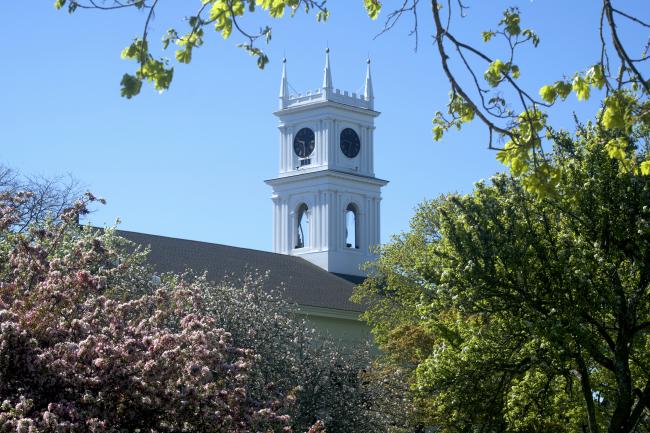
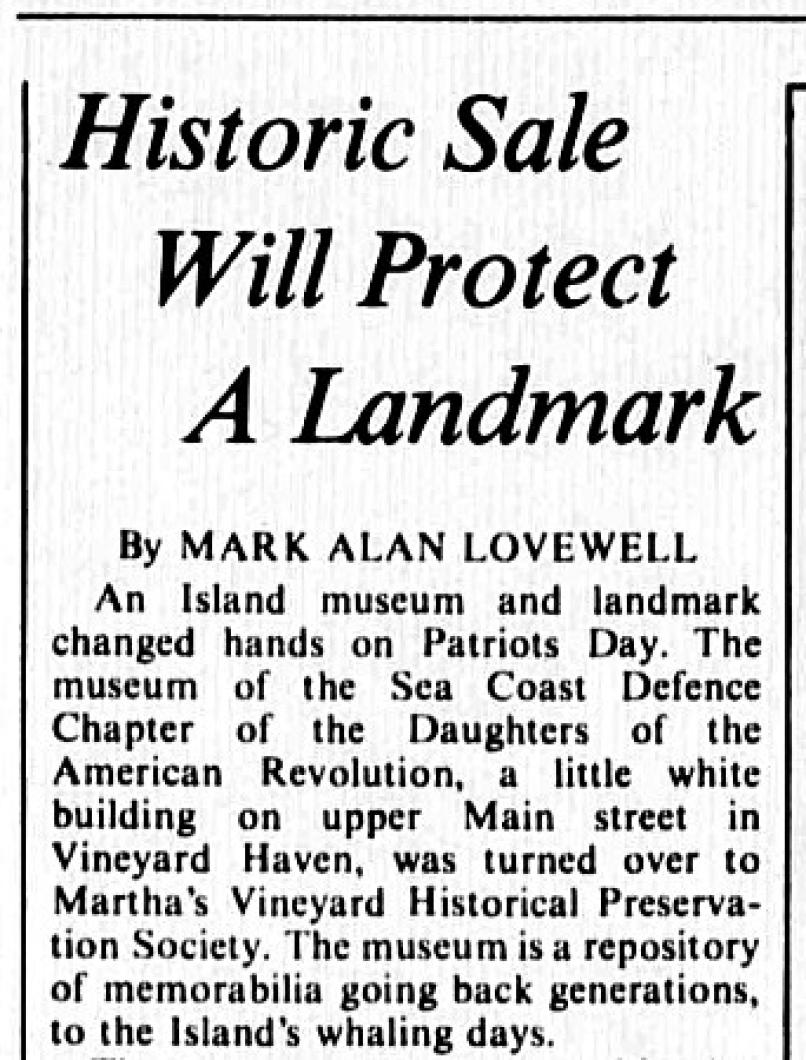



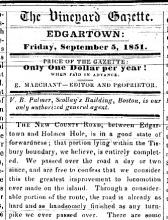
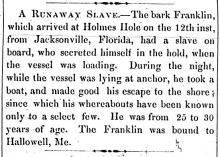

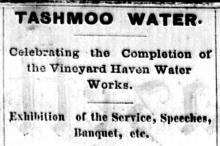
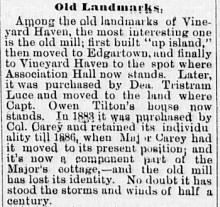
Comments